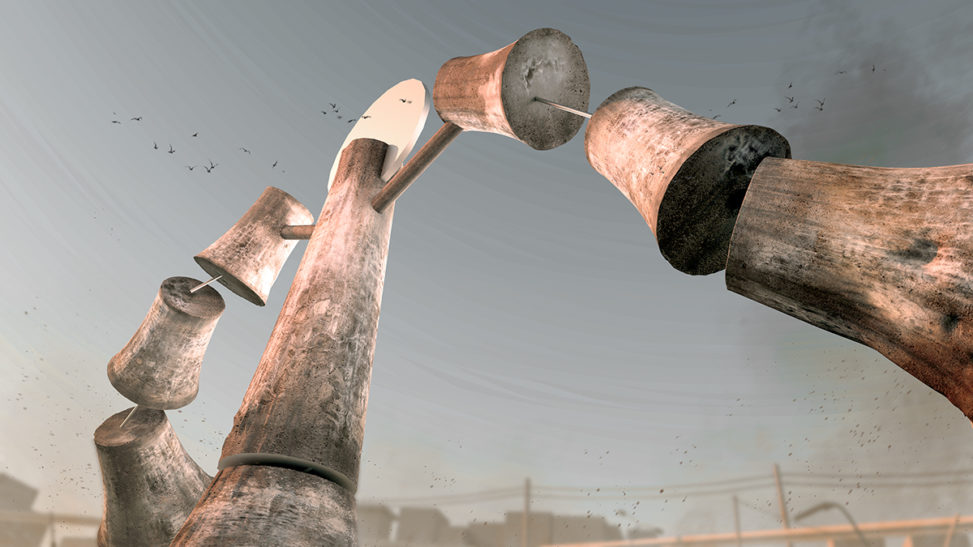在人造物吞噬最後一片荒野之前,人類社會中的建設擴張者與環境保護者,持續出現衝突對立;城市中,各式科技產品與建物不斷生成,追求更快、更好、更精準的未來世界。與此同時,被人類掠奪的自然資源正在逐漸消耗殆盡 。
然而,一群巨型破壞者的出現——我們稱之為 動態體 ——改變了當時的人們習以為常的社會秩序。不同於創造疊加或保護現存生態,遍佈各地的它們,透過從陸上與陸下毀壞人造物,阻止都市擴張,試圖觸發近未來世界中新的循環模式。
Before man-made objects consume the last wilderness, the construction expanders and environmentalists continue to have conflict and discord; in the cities, various technological products and buildings are constantly being produced, pursuing a faster, better, and more precise future world. At the same time, the natural resources plundered by humans are gradually being exhausted.
But, the emergence of groups of giant saboteurs — called Dynamic Beings — threatened to change the social order that people are accustomed to. Different from superposing or protecting the existing ecology, and by destroying man-made objects from land and underneath, those ubiquitous creatures obstructed the urban expansion, attempting to trigger a new circulation pattern in the near future world.
近未來世界中,出現了一群巨大的破壞者。它們遍佈全球,出現在陸上與地下,前往各個綠地不足的區域,透過撞擊人造建物、毀壞路面,阻止都市擴張——它們被稱為「動態體」。
In the near future, huge saboteurs appear and roam the world, they spread all over the lands and underneath in large numbers, going to areas with insufficient green vegetation, upsetting urban expansion by smashing man-made structures and demolishing the roads — they are called “Dynamic Beings”.

Normalized Difference Vegetation Index (NDVI)
NDVI 為評估一區植物生長狀況的數值指標,透過衛星探測地表反射的紅光與近紅外光,得出其波長和強度,以此來量化綠色植被的生長密度。¹ 當時的人們發現,動態體會依據NDVI的數值行動。當接收到的數值太低,顯示植被生長密度不足時,動態體就會進行破壞。
NDVI is a numerical indicator for assessing the plant growth status of a region. By deriving the wavelengths and amplitudes of the red light and near infrared ray, the growth density of green vegetation can thus be quantified.¹ People at the time found that Dynamic Beings act depending on the value of NDVI. When the plant growth status value of the surrounding area is too low and the surface green vegetation is lacking, Dynamic Being will begin to destroy.
•••

水生動態體 Aquatic Dynamic Beings
水生動態體由最前方的領頭者帶領,群集漂浮於下水道,定期接收來自衛星的NDVI數據。當周遭地區的數值過低,地表綠地不足時,為了阻止都市擴張,前方領頭的水生動態體會發出高亢鳴叫,促使群體收縮身軀,高速噴發液體,並以所含細菌與強酸來侵蝕弱化混凝土結構。與此同時,鳴叫聲也呼喚位於地面上的「陸生動態體」,以強而有力的撞擊將地面打裂。
Flocking in sewers, “Aquatic Dynamic Beings” regularly receive NDVI data from satellites. When the plant growth status value of the surrounding area is too low and the surface green vegetation is lacking, in order to hamper the urban expansion, the forefront leader will call out high-pitched screams, prompting the group to shrink forcefully and spray liquid at high speed like whale spraying, eroding and weakening the concrete structure with bacteria and strong acid. At the same time, its calls summon “Terrestrial Dynamic Beings” on the surface, and they exert powerful impact to crack the ground.

“Aquatic Dynamic Beings” spraying liquid that contains bacteria and strong acid
•••

陸生動態體 Terrestrial Dynamic Beings
這個八公尺高的龐然大物,每當聽見地下傳來的水生動態體鳴叫聲,就會挪動沈重的身體前往該地,透過甩動軀幹,如象鼻般多節的雙臂能夠大力撞擊,破壞都市中的人造物與被細菌侵蝕過的路面。
This behemoth — towering over eight-meters tall — moves its heavy body to where it is needed, in response to the cries of Aquatic Dynamic Beings from beneath the ground. By lashing its torso, its segmented trunk-like arms brandish vigorously, striking and destroying man-made objects in the cities and demolishing surfaces that have been eroded by bacteria and acid from beneath.


Terrestrial Dynamic Beings smashing

Anatomy of Terrestrial Dynamic Beings
人們將故障、不再運行的動態體拆解分析,了解它們的運作方式。然而,這些數量眾多,行走於城市當中的巨大破壞者,它們究竟從何而來,仍未有定論。是機械的自我演化?人類社會發展過剩後的清理機制?是激進團體所為?抑或是人類以外的智慧生物所創造?對此依舊眾說紛紜。
Humans disassemble and analyze the malfunctioning Dynamic Beings that are no longer operating to understand how they work. However, where these huge saboteurs — those tramping the cities in large numbers — came from is still unclear. Is it the self-evolution of machinery? Is it the clean-up mechanism to offset the overdevelopment of human society? Is it the work of extremists? Or is it created by intelligent creatures other than humans? There are still controversies over this matter.

Movement of Terrestrial Dynamic Beings
•••
與數百萬年前遙相呼應
Echoing the Megafauna Millions of Years Ago
人們逐漸觀察到,這群動態體在當代扮演的角色,似乎隱約呼應數百萬年前,巨型動物群² 的行為:藉由踩踏、進食破壞植被,加速生態物質循環,提升棲地中的生物多樣性;動態體則是破壞人造建物,創造出可供人類以外的生物得以遷徙的生態區位,雖導致人類的不便,卻也在都市生態系中製造出異於水泥、柏油路的地貌,利於生物存續的環境。
Humans have gradually realized that the role of this Dynamic Beings in their contemporary times seems to echo that of the megafauna millions of years ago² : to cause destruction of vegetation by trampling and consumption, to facilitate the ecological material cycle and biodiversity in the habitat; while Dynamic Beings destroy man-made concrete jungle and create ecological niche for the migration of organisms other than the human. Although it causes some inconvenience for humans, it also creates a landscape without concrete buildings and asphalt roads, an environment conducive to the survival of organisms.
近未來世界中的日常景況
The Daily Life in the Near Future
地底噴發水柱,街燈倒塌,路面崩裂,伴隨低沈的腳步聲與高亢的鳴叫⋯⋯
這是近未來世界中的日常景況。
不過,我們自己願意活在這樣的世界嗎?
答案恐怕是否定的。
我們設想了動態體的存在,卻又矛盾地希望動態體不要出現,動搖我們的安穩日常。
然而,這樣的世界看似超現實,卻非全無可能。
更新世的物種環境催生巨型動物群的蓬勃、破壞植被,說不定,現代大量消耗有限資源的生活模式,就是導致動態體出現,破壞人造物的推手。
Water spray erupts from underneath,
street lights fall over,
and roads crack,
accompanied by low roar rumbling footsteps and high-pitched calls…
the daily happenings in the near future world.
However, are we willing to live in such a world?
The answer is probably negative.
Although such a world seems surreal, it is not impossible. The Pleistocene ecological environment gave birth to the vigorous megafauna and altered the balance between woody and herbaceous vegetations. Perhaps the modern lifestyle, which is based on constant superposing and producing, would be the driving force behind the emergence of Dynamic Beings and the destruction of man-made objects.
We speculated the existence of Dynamic Beings, but ambivalently hope that Dynamic Beings will not appear
and shake our peaceful and stable daily lives. Nevertheless, would the desire of ease and comfort be the main reason people refuse to face the problems, causing the social order to collapse?
在動態體的世界中
In the World of Dynamic Beings
當動態體的鳴叫於城市中響起,覆蓋了你我耳機裡的音樂,當數層樓高的古怪巨物出現於眼前,我們是否會想起深埋在集體潛意識中,先祖對於巨型動物群的記憶?
我們會感到畏懼,還是想要征服?
人類將更加堅定屏除一切不符合都市規矩的事物,還是會選擇做出改變,重新思考我們早已習慣的、社會中現存的運行規則?我們對於未來的想像——乾淨明亮的都市街道,人工智能包辦一切事務,人類只需待在家中,透過虛擬實境體驗生活——是否有其他的可能性?
說不定,在有動態體的世界中,速度與效率不再是價值判斷唯一的標準,說不定除了建設公司,還會出現破壞企業;房屋從不動產成為動產⋯⋯當破壞成為日常生活的一部分,人類將居住在迥異於現有社會架構的環境之中。
When the tweets of Dynamic Beings reverberating in the cities, masking the music playing in our earphones, when the weird behemoths several stories high show up before our eyes, would we recall the memories buried deep in the collective subconscious of our past, of those giant animals that our ancestors had confronted?
Would we be afraid, or do we want to conquer?
Would humans be more determined to reject everything that does not conform to their urban rules, or would they choose to make changes and rethink the established social operation practices that we have long been accustomed to?
Is our imagination of the future — clean and bright streets and roads, artificial intelligence that takes care of everything, all the humans need to do is staying at home and experience life through virtual reality — predestined, or are there other possibilities?
Perhaps, in a world of Dynamic Beings, speed and efficiency are no longer the only criteria for value judgment. Perhaps, in addition to construction companies, there may will be destruction businesses as well; houses are no longer real property but rather movable property.
When destruction becomes part of the daily life, the environment in which humans live will be very different from that of the current social structure.
•••
Reference & Note
1. Weier J., Herring D. (2000), “Measuring Vegetation (NDVE & EVI),” NASA Earth Observatory website: http://earthobservatory.nasa.gov/Features/MeasuringVegetation/.
2. Malhi Y. et al. (2016), ‘Megafauna and ecosystem function from the Pleistocene to the Anthropocene’, Proceedings of the National Academy of Science of the USA 113: 838-846.
•••
蔡怡亭 高映涵, 《動態體 Dynamic Beings》,
推測敘事, 推測敘事短片7m12s, 2021
指導 何樵暐
總召 鄭司維
模型作動結構製作 鄭宇劭 吳昱辰
陸生動態體解剖圖 林迺凱
特別感謝 陳羽薰助理教授, 蔡政修助理教授, 蕭勝文老師, 施皇旭老師, 林時旭老師, 黃子綸, 蔡承志


